Tom Parkinson's monthly column, introducing the diverse range of flora and fauna on show at Sanctuary Lakes.
The quiet, warm and long shadowy summer evenings on the golf course have become a time for Sanctuary Lakes most plentiful mammal population to leave their warrens and hideaways to munch into their supper of favourite grasses. The Rabbits and Hares are ferocious eaters of all things green, gold medallists' in breeding with at least three litters a year and unfortunately if not controlled an extreme pest.
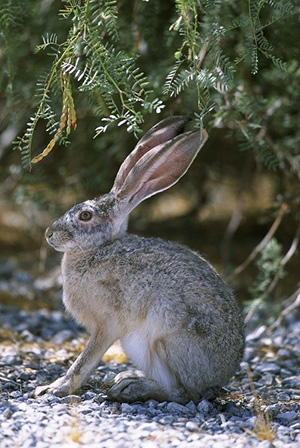 Hare Lepus europaeus The Hares and Rabbits were introduced in this area by the Chirnside Brothers in the 1850s along with foxes and deer. There being no natural predator other than the Chirnside Brothers and their Coterie of Hunters, plus the occasional fox with a yearning for a European palate, the Hares and Rabbits of Point Cook literally "breed like rabbits". Even today after a 100 year of eradication programs, the Park Victoria Ranger tells me that this year's eradication cull in the Point Cook Homestead and Cheetham Wetland area will be over 2,700 and that they believe is about 60% of the population.
Hare Lepus europaeus The Hares and Rabbits were introduced in this area by the Chirnside Brothers in the 1850s along with foxes and deer. There being no natural predator other than the Chirnside Brothers and their Coterie of Hunters, plus the occasional fox with a yearning for a European palate, the Hares and Rabbits of Point Cook literally "breed like rabbits". Even today after a 100 year of eradication programs, the Park Victoria Ranger tells me that this year's eradication cull in the Point Cook Homestead and Cheetham Wetland area will be over 2,700 and that they believe is about 60% of the population.
It is a different picture here in the Sanctuary Lakes Resort and on the Golf Course. Our Course Superintendent Dylan Knight tells me that thanks to the half a dozen or so of our neighbourhood Foxes, there are a very manageable 250 plus Hares and no more than 150 Rabbits in and around the Golf Course. As long as these numbers can be maintained it is an excellent ecological balance. It means we don’t need the dangerous risk with a high human population density, of poisons and shooting eradication culls. And we have the advantage of Rabbits and Hares controlling some difficult overgrowth which leads naturally to excellent fertiliser.
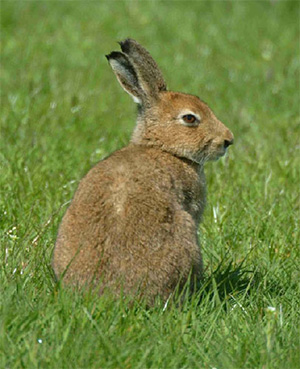 Rabbit Oryctolagus cuniculust Hares and Rabbits look similar, and some may hop to the conclusion that they're the same animal. They are in the same family, Leporidae, but they're different species. Hares are much larger, have a lot longer ears, and are less social than Rabbits.
Rabbit Oryctolagus cuniculust Hares and Rabbits look similar, and some may hop to the conclusion that they're the same animal. They are in the same family, Leporidae, but they're different species. Hares are much larger, have a lot longer ears, and are less social than Rabbits.
But the most profound difference is seen in baby Hares versus baby bunnies. A Hare's pregnancy lasts 42 days, compared with Rabbits' 30-31 days with a bunny in the oven. Newborn Hares, called leverets, are fully developed at birth—furred with open eyes—while newborn Rabbits, called kittens or kits, are born undeveloped, with closed eyes, no fur, and an inability to regulate their own temperature.
Rabbits have induced ovulators, which means that mother Rabbit can be impregnated again within minutes of giving birth. This means that mama could, hypothetically, have one litter averaging six bunnies per month.
Hares are known to have between two to three litters averaging four leverets, per year.
Rabbits and Hares nests are also worlds apart. Hares live completely above ground, lacking the normal burrow or warren system of Rabbits.
Speed is crucial for a Hares' survival. They are known to run at 37 body lengths a second, out pacing even Cheetahs which can only manage 23 body lengths per second.
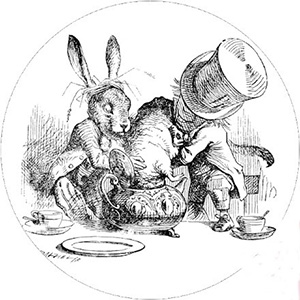 John Tenniel's White Rabbit from Alice in Wonderland The Hares speed may be great for avoiding predators, but it makes them very poor pets whereas the less speedy Rabbits, as every school child knows, make delightful companion animals.
John Tenniel's White Rabbit from Alice in Wonderland The Hares speed may be great for avoiding predators, but it makes them very poor pets whereas the less speedy Rabbits, as every school child knows, make delightful companion animals.
Throughout the world in almost every human culture, the Rabbit and Hare have been subject to anthropopathism that is the ascription of human characteristics, feelings, language and even clothing to an animal. In African mythology they were always tricksters and this became part of the Afro-American tradition with stories such as Br'er Rabbit. In Japan, Korea and China, rabbits live on the Moon and the Japanese believe they are busy making mochi, (mashed sticky rice) this comes from interpreting the pattern of dark patches on the moon as a Rabbit. In the European tradition, the Hare and Rabbit symbolise the two qualities of swiftness and timidity. In that most famous of Greek tales, the Aesop's Fables, the best-known is possibly "The Tortoise and the Hare" where the Hare loses a race through being too confident in its swiftness. In Irish folklore, they are often associated with the little people and other pagan elements. In these stories, characters who harm Hares and Rabbits will suffer dreadful consequences.
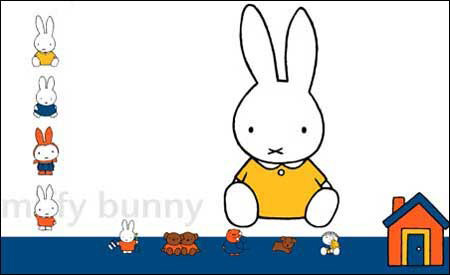 Dick Bruna's Miffy Bunny Rabbits are often used as a symbol of fertility or rebirth, and have long been associated with spring and Easter as the Easter Bunny. The species' role as a prey animal also lends itself as a symbol of innocence, another Easter connotation.
Dick Bruna's Miffy Bunny Rabbits are often used as a symbol of fertility or rebirth, and have long been associated with spring and Easter as the Easter Bunny. The species' role as a prey animal also lends itself as a symbol of innocence, another Easter connotation.
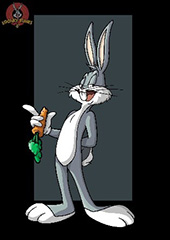 Bugs Bunny - What's Up, Doc? Anthropomorphized Rabbits and Hares have appeared in a host of works of film, literature, and technology, notably the White Rabbit and the March Hare in Lewis Carroll's Alice's Adventures in Wonderland; in the popular novels Watership Down, by Richard Adams, along with its film and television adaptations, Rabbit Hill by Robert Lawson, as well as in Beatrix Potter's Peter Rabbit stories. In animation the legendry Bugs Bunny and the Pre-school stalwart, Miffy Bunny books.
Bugs Bunny - What's Up, Doc? Anthropomorphized Rabbits and Hares have appeared in a host of works of film, literature, and technology, notably the White Rabbit and the March Hare in Lewis Carroll's Alice's Adventures in Wonderland; in the popular novels Watership Down, by Richard Adams, along with its film and television adaptations, Rabbit Hill by Robert Lawson, as well as in Beatrix Potter's Peter Rabbit stories. In animation the legendry Bugs Bunny and the Pre-school stalwart, Miffy Bunny books.
I cannot let the opportunity pass and not mention one of the great iconic animal paintings, that acknowledge masterpiece of animal observation, Albrecht Durer's "The Young Hare" Painted in 1502 using watercolour and bodycolour (gouache) it has an almost photographic realism and a perfect compositional narrative.
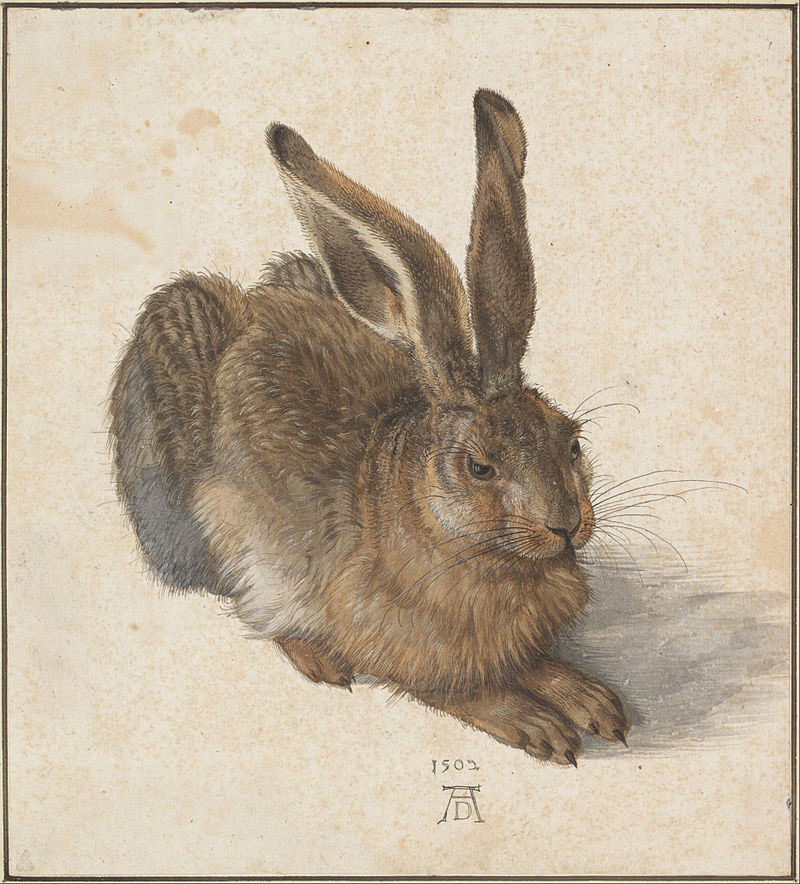
Durer managed to create an extremely detailed and very accurate portrayal of a Hare, mottled with dark and light patches, with its fur pointing in many directions. He patiently built up the texture of the fur with a multitude variety of equally dark and light brushstrokes. The picture is infused with warmth, a golden light that strikes the hare on the left side, highlighting the ears, illuminating the fur along the left side. The painting was brought to completion with the addition of a few refined details such as the whiskers and the meticulous reflection of a window in the Hare's eye.
Durer's painting of the Young Hare can be seen in the Albertina Museum in Vienna but we Sanctuary Lakers have the edge in enjoyment, as we can on any summer evening wander the golf course and see the real Hares and Rabbits gambling on the fairways and their fringes.